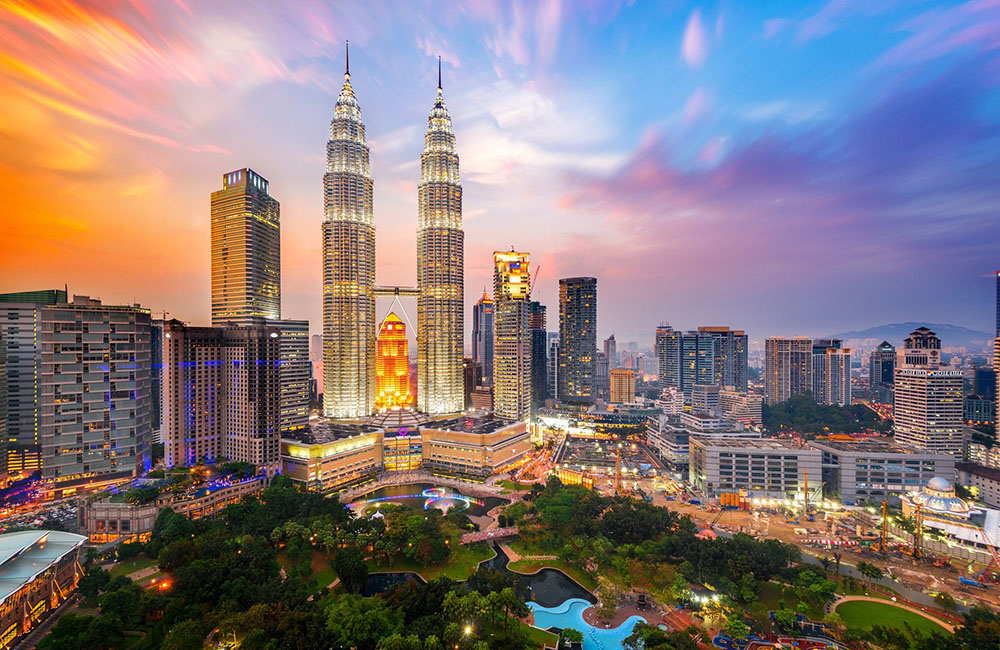Malaysia - A country profile

This article provides an overview of Malaysia for those keen on exploring the possibility of living and working there. The information presented is gathered from open sources and is not exhaustive or meant to supplement or substitute legal and professional advice.
Key facts
- Capital: Kuala Lumpur1
- Geography: 13 states and 3 federal territories2
- Land area: 330,524 sq km3
- Population (2024): 34.1 million4
- Head of government: Prime Minister Dato’ Sri Ismail Sabri bin Yaakob5
- National language: Bahasa Malaysia6
- Currency: Malaysian Ringgit (MYR)7
- GDP (2023): MYR1.82 trillion8
- GDP per capita (2023): MYR53,0269
Introduction
Malaysia comprises two regions: the Peninsular Malaysia and the states of Sabah and Sarawak. It is a multi-ethnic and multi-religious federation of 13 states and three federal territories.10 The states of East Malaysia (Sabah and Sarawak) have separate immigration policies and controls.11
Demographic profile
In 2024, the population in Malaysia is estimated at 34.1 million, with 30.7 million citizens and 3.4 million non-citizens. The population grew 1.9 percent, an increase from the 33.5 million recorded in 2023. The population of males outnumbers that of females: in 2020, the gender ratio is 1.11 male to one female. The Malaysian population comprises many ethnic groups. In 2020, more than 69 percent of the population were Bumiputera, which included Malays, Orang Asli, and Sabah and Sarawak natives.12
Economic profile
Malaysia’s economy grew at a moderate rate of 3.6 percent in 2023, attaining a gross domestic product (GDP) of MYR1.82 trillion. Growth was led by the services sector and manufacturing sector, which accounted for 82.6 percent of total GDP. The country’s GDP per capita fell slightly from MYR53,121 in 2022 to MYR53,026 in 2019.13
Industry
Malaysia’s services industry grew by 5.1 percent from the previous year in 2023, led by wholesale and retail trade, transportation & storage, and food & beverage sub-sectors.14
The manufacturing industry became a significant contributor to the country’s economy in the post-independence period beginning in the 1960s.15 In 2023, the manufacturing industry recorded a slower 0.7 percent growth. Leading Malaysia’s manufacturing industry is the motor vehicles & transport equipment, food processing, and fabricated metal products sub-sectors.16
Other sectors such as agriculture, mining & quarrying, and construction are other sectors contributing largely to Malaysia’s GDP. 17
Tourism
Malaysia’s attractions include towering skyscrapers, rugged mountains, sandy beaches and cool highland hideaways.18 The Petronas Twin Towers, also known as KLCC, is an iconic 88-storey twin building located in the capital Kuala Lumpur and is a popular tourist photography spot.19 Mount Kinabalu, located in Sabah, is the highest mountain in Southeast Asia, standing at 4,095 metres and well-known for its botanical and biological species biodiversity.20 Malaysia is also home to many beautiful islands such as Pulau Tioman and Pulau Sipadan, which are popular among snorkelers and divers. Its diverse culture also makes the country a “gastronomical paradise” which attracts visitors.21
In 2023, tourism brought 28.9 million international tourist arrivals who contributed MYR275.8 billion (or 15.1 percent) to the country’s GDP.22 Tourist arrivals in 2023 were dominated by visitors from Singapore with 18.85 million arrivals, followed by Indonesia (4.14 million arrivals) and China (3.72 million arrivals).23
References
-
Kuala Lumpur. (2024, April 8). Encyclopaedia Britannica. Retrieved April 4, 2024, from https://www.britannica.com ↩
-
About Malaysia. (2023). Malaysia Tourism Promotion Board. Retrieved August 14, 2023, from http://www.malaysia.travel ↩
-
Malaysia statistical handbook (p. 1). (2019, October). Department of Statistics Malaysia. Retrieved November 18, 2020, from https://www.dosm.gov.my ↩
-
Current population estimates, Malaysia, 2024. (2020, July 15). Department of Statistics Malaysia. Retrieved November 18, 2020, from https://www.dosm.gov.my ↩
-
Ahli-Ahli Jemaah Menteri. (2024, April 8). Jabatan Perdana Menteri. Retrieved April 4, 2024, from https://www.kabinet.gov.my/ ↩
-
Official language. (2020). MyGovernment. Retrieved November 18, 2020, from https://www.malaysia.gov.my/ ↩
-
Currency. (2020). MyGovernment. Retrieved November 18, 2020, from http://www.malaysia.gov.my ↩
-
Gross Domestic Product 2023. (2024, May 17). Department of Statistics Malaysia. Retrieved July 15, 2025, from https://www.dosm.gov.my ↩
-
Gross Domestic Product 2023. (2024, May 17). Department of Statistics Malaysia. Retrieved July 15, 2025, from https://www.dosm.gov.my ↩
-
About Malaysia. (2009, December 31). Ministry of Foreign Affairs, Malaysia. Retrieved November 18, 2020, from https://www.kln.gov.my ; Demography of population. (n.d.). MyGovernment. Retrieved November 18, 2020, from https://www.malaysia.gov.my ↩
-
Malaysia: East Malaysia immigration requirements and practices. (2017, February). PwC. Retrieved April 9, 2024, from https://www.pwc.com ↩
-
Current population estimates, Malaysia, 2024. (2020, July 15). Department of Statistics Malaysia. Retrieved July 15, 2025, from https://www.dosm.gov.my ; Leong, T. (2017, August 3). Who are Malaysia’s bumiputera? The Straits Times. Retrieved October 10, 2018, from http://www.straitstimes.com ↩
-
Gross Domestic Product 2023. (2024, May 17). Department of Statistics Malaysia. Retrieved July 15, 2025, from https://www.dosm.gov.my ↩
-
Gross Domestic Product 2023. (2024, May 17). Department of Statistics Malaysia. Retrieved July 15, 2025, from https://www.dosm.gov.my ↩
-
Lee, C. (2019, February). Manufacturing performance and services inputs: Evidence from Malaysia. ISEAS Yusof Ishak Institute Economics Working Paper No. 2019-02. Retrieved November 18, 2020, from https://www.iseas.edu.sg; ↩
-
Gross Domestic Product 2023. (2024, May 17). Department of Statistics Malaysia. Retrieved July 15, 2025, from https://www.dosm.gov.my ↩
-
Gross Domestic Product 2023. (2024, May 17). Department of Statistics Malaysia. Retrieved July 15, 2025, from https://www.dosm.gov.my ↩
-
About Malaysia. (2020). Prince Court. Retrieved November 18, 2020, from https://princecourt.com ↩
-
The majestic Petronas Twin Towers. (n.d.). Malaysia Truly Asia. Retrieved November 18, 2020, from http://www.malaysia.travel ↩
-
Mount Kinabalu. (n.d.). Malaysia Tourism Promotion Board. Retrieved August 14, 2023, from http://www.malaysia.travel ↩
-
20 Awesome and True Malaysian Breakfast. (2023). Malaysia Tourism Promotion Board. Retrieved August 14, 2023, http://www.malaysia.travel ↩
-
Tourism satellite account 2023. (2024, September 12). Department of Statistics Malaysia. Retrieved July 15, 2025, from https://www.dosm.gov.my ↩
-
Arrivals by country. (2020). My Tourism Data. Retrieved November 18, 2020, from http://data.tourism.gov.my ↩

